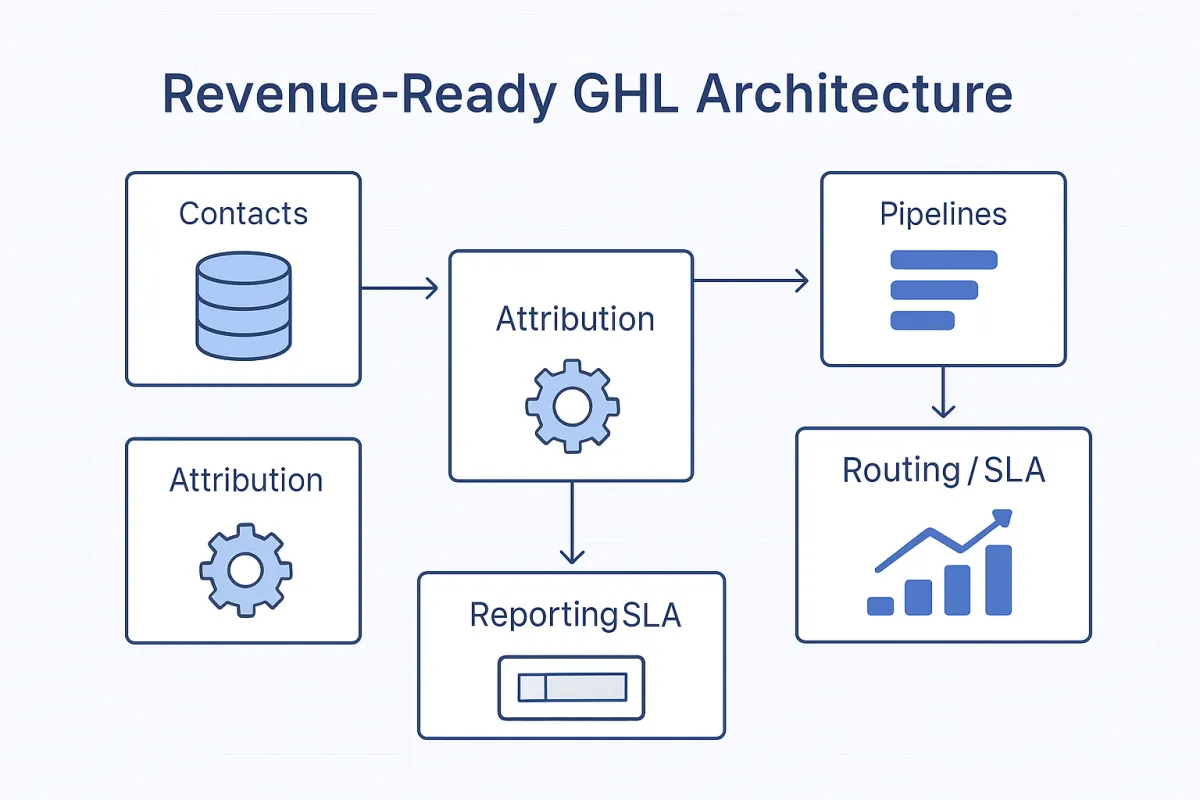
Revenue-Ready GHL Architecture
“Systems create outcomes; outcomes don’t create systems.” — Dependable Consulting
Introduction:
If your GoHighLevel runs on one-off zaps and copy-pasted snapshots, you’ll get lumpy results and tangled attribution. This post lays out the opinionated architecture that stops “random acts of automation” and turns every field, tag, and pipeline stage into revenue telemetry you can trust.
1. Opinionated data model (fields, tags, objects)
Define required fields for contactability, attribution, routing, and reporting. Lock naming, casing, and allowed values. If a field doesn’t power routing or reporting, it’s noise—remove it.
2. Pipeline taxonomy & dispositions
Standardize stages and exit reasons so ops and execs see the same truth. Tie every move to a disposition (won, lost, recycle, nurture) to preserve learning loops and forecasting.
3. Attribution you can reconcile
Capture UTMs at the edge (forms, chat, click-to-call) with cookie persistence and fallbacks. Store first and last touch, and record the hand-offs so “source of truth” survives reality.
4. Environments & change control
Treat snapshots like releases (dev → stage → prod). Version them, diff them, and roll back safely. No editing in prod without a ticket and a checklist.
5. Routing & SLAs (speed-to-lead that sticks)
Route by skills, geo, license, and availability. Enforce response-time SLAs with alerts and auto-escalation so leads never stall quietly.
6. Reliable integrations (webhooks, APIs, middleware)
Make calls idempotent; queue retries; add dead-letter handling. Duplicate prevention and merge logic protect attribution and reporting.
7. QA gates & automation health
Continuously check for missing required fields, failed sends, and stuck deals. Alert before sales notices, not after.
8. Reporting that drives decisions
Build two views: an operator dashboard for today’s fires and an exec dashboard for CAC/LTV, payback, and stage conversion trends. If it can’t change a decision, don’t chart it.
Other resources to help you get started with architecture
Pipeline Taxonomy & Dispositions (how to name stages and exit criteria)
UTM Capture & Source-of-Truth Setup (hidden fields + cookie persistence)
Snapshots, Environments & Change Control (your release process)
QA Gates & Automation Health Monitoring (catch breakages early)
Reporting & Dashboards (Exec vs Ops) (what to show to whom)
Start your own architecture checklist:
Map the minimum required fields for contactability, attribution, routing, reporting.
Write the stage/disposition table and publish it to the team.
Add hidden UTM + first/last touch capture to all forms, chat, and click-to-call.
Create dev, stage, prod snapshots; define a rollback procedure.
Implement skills/geo routing with response-time SLAs and escalation.
Add idempotent webhooks, retries, and a dead-letter queue.
Turn on automated QA checks for missing fields, failed sends, and stuck deals.
Ship the exec + operator dashboards and review them weekly.
